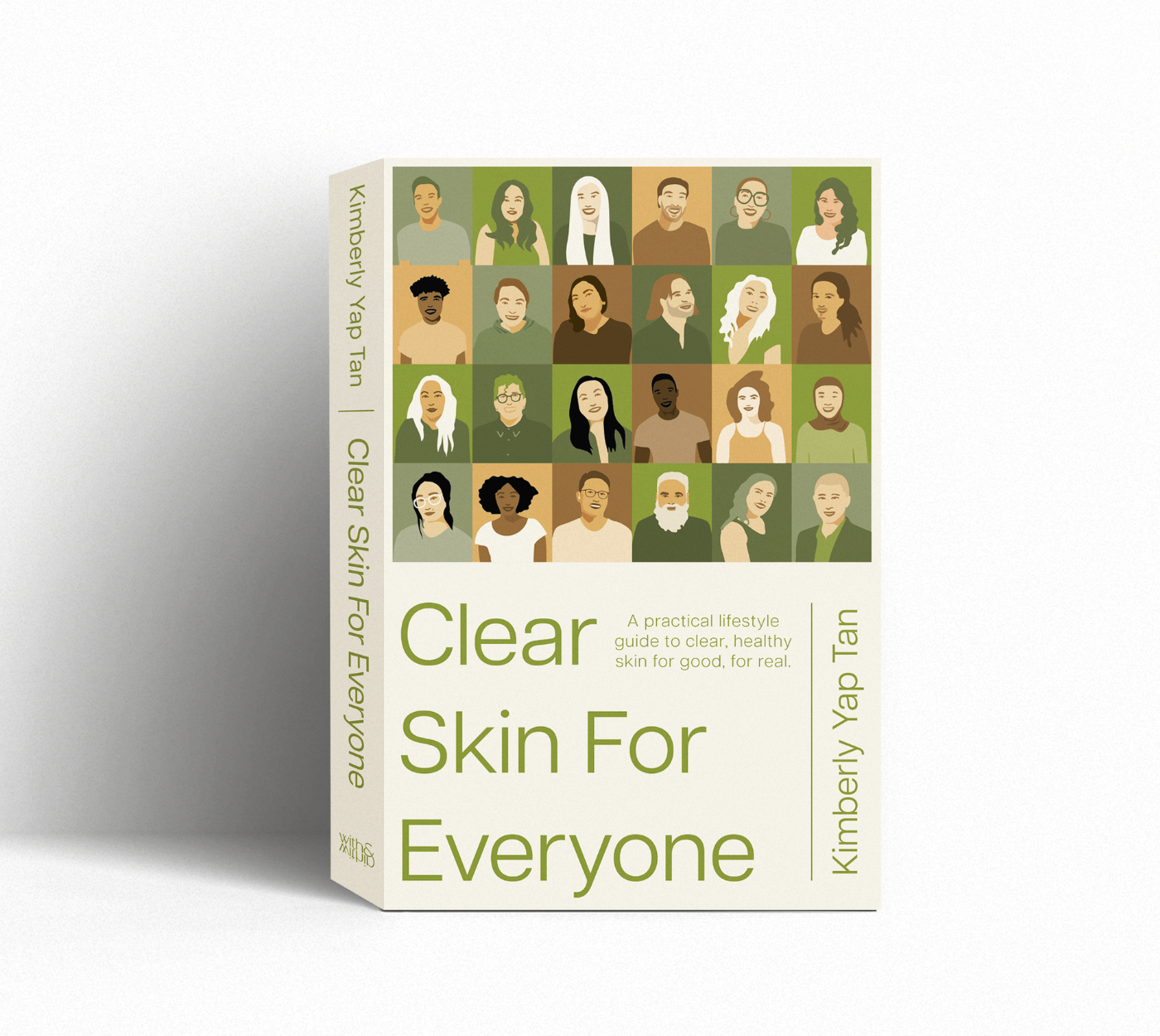
what's your skin type?

the skin is the largest living organ your body has, so it's important to take good care of it. it literally holds us together, serves as our waterproof jacket, and is flexible accommodating our growth through life. but how do you know how to take care of it, if you don't know what kind of skin you have in the first place? think of navigating skincare like assessing the weather for the day, and dressing accordingly.. you may wear a big puff coat for cold weather, and a tank top for warmer weather.
your skin will generally be 1 of 3 things:
- oily all over (even on the cheeks, with larger pores)
- dry all over (tightness, dull, slight wrinkling is common with smaller pores), or
- a combination of both.
most people have a combination of both, where folks are slightly oilier in the t-zone (forehead, nose and maybe chin) and not so oily on the cheeks. that said, it’s totally normal for your t-zone to be a bit shiny or oily at the end of a workday. the goal with good skin is not to never have oily skin. it’s just to learn how to manage what you’ve got!
read on for my take on the different skin types, how weather and products can affect it and info on how to "reset" your skin to find its true nature.
DRY SKIN
what it looks like:
truly dry skin is usually thin and fine textured, with very small to invisible pores, including those on the t-zone. there is very little if any, oil present on the skin, even on the t-zone. sometimes the skin is so dry one might see superficial wrinkling (kind of like a crinkled up tissue), or have a rough texture, which is relieved with extra moisturizing, and a break from active products.
what it feels like:
after washing, dry skin will feel tight, look a bit wrinkly (as above) and may even start to slightly flake in areas (particularly around the mouth or eyes) within an hour of not moisturizing. sometimes applying moisturizers can sting, even if they contain no active ingredients in them. you may also feel some roughness as the dead skin cells collect at the surface, that gets worse with exfoliation but goes away when you stop all actives and moisturize extra instead.
what to look for and buy:
you’ll want to look for and use non-foaming cleansers (lotion or cream textured), and creams to moisturize with. if more moisture is needed, add a product like a moisturizing serum, acne-safe oil or hydrating mask to your regimen for as long as you’re still extra dry, and back off when your skin isn’t. products with too much moisture for your skin, even if acne-safe, can make you break out.
active product tolerance:
dry skin can tolerate some exfoliants, but start slowly, and carefully watch your skin’s behavior to monitor any trouble. dry skin can quickly get over-exfoliated or dehydrated if too many active products are introduced too soon in frequency, concentration or quantity.
seasons / climate:
warm weather is usually the most comfortable for this skin type, as the heat helps the skin create more sebum.
in cold-weather areas or seasons, you will likely need even more moisture support. you can do this by:
- layering an extra coat of cream or lotion on when moisturizing, allowing the previous layer to soak in before the second application
- introducing a hydrating serum under your moisturizer above, like with a few drops of acne-safe oil (read this) or a natural difference’s rejuvenation concentrate
- incorporating a moisturizing treatment mask, like the skinscript goji berry mask, a few times a week.
OILY SKIN
what it looks like:
truly oily skin usually thick with visible pores that are largest on the t-zone and smallest on the cheeks closest to the ears. sometimes tiny drops of oil can be found coming out of each pore! sebaceous hyperplasia is also common. this is a type of enlarged sebaceous gland, where close-up, the pore looks a bit like a volcano: extra skin cells have “erupted,” overflowing out of the pore causing a bump.
what it feels like:
immediately after washing, the skin will feel comfortable - neither dry nor oily - but within an hour the skin will start to feel oily, a sheen may develop. your eyeglasses are often greasy, and the skin feels oily to the touch all over the face, including on the cheeks.
what to look for and buy:
find a gentle foaming cleanser, and a light moisturizing gel or lotion. gel may not be enough for most, so layer up with or instead use a lotion if that’s the case. if you’re really oily, look for a foaming benzoyl peroxide based cleanser, which will help absorb excess oil. you can also use it like a mask by foaming it up, applying it to the skin and waiting a few minutes before rinsing off. you’ll still need to moisturize after though so make sure to do that!
active product tolerance:
oily skins generally can tolerate stronger exfoliants, because the oil “floats” the actives at the surface, preventing them from being absorbed into the skin. thus, just a bit of drying is needed to absorb this excess, to allow the actives to penetrate into the pore to work. however, oily skinned folks that over-dry the skin (with too drying products, use extremely hot water or who skip moisturizing) can cause dehydration, resulting in the skin overproducing oil in an attempt to (over)compensate for the oil you dried up. even if you’re oily, be gentle with your skin!
seasons / climate:
warm weather usually makes this skin type more oily, making the colder and drier climes more comfortable. however, you may still need to moisturize even a tiny bit, to support the skin during the weather change and prevent dehydration. you’ll want to look for:
- cleansers that foam up, because the foaming action is inherently drying. a well formulated one won’t overdry or strip.
- look for serums, gels and/or lotions to moisturize the skin. creams will generally be too oily for this skin type.
- mineral based sunscreens are inherently slightly drying, so might be a good choice for oily skinned folks.
COMBINATION a.k.a. normal skin
most people fall under this category, which is a mix of both oily and dry. like genders, skin types are not a binary! this combo can change on the day, and is subject to the weather, climate or drugs you may be taking.
the classic combination skin is usually a little oily on the t-zone, and a little dry on the cheeks; not too more one than the other. it’s normal to have a bit of an oily t-zone in the afternoon, especially if you’ve had a stressful or warm day.
products to look for and buy:
kind of a combination of both stated above. i personally have combination skin that veers slightly on the drier side, so keep 2 cleansers on hand (the foaming charcoal and creamy hydrating ones) to switch off of, depending on how my skin is feeling that day. then i’ll use our hydrating cream (suitable for most skin types). if i’m feeling dry, i’ll apply this twice for extra moisture. if i’m extra dry, i’ll sneak a few drops of safflower or sunflower oil on my skin after toning and before the cream.
REBALANCING THE SKIN to learn what skin type you really are
your skin may be imbalanced because of the current regimen you're using. for instance, if you're using a ton of drying products, you may (falsely) think your skin is dry. or if you're oil cleansing and moisturizing with a heavy cream, you may believe your skin is oily when it's actually the products you're using.
- stop all actives (anything with acids, retinols, scrubs, scrubby things, or drying things like benzoyl peroxide or clays)
- choose and stick with one cleanser and one moisturizer
see how your skin does for a week or two with your one cleanser and one moisturizer products mentioned above and if your skin feels comfortable (meaning not too oily or dry) you’ve likely found the right combo (for this point in time + season + climate, anyway).
fluctuations in these variables can cause your skin to change, so you'll want to adjust your products + approach to how your skin is behaving that day. try one of the strategies below for a few days to see how your skin does, before you change up another.
- if you’re feeling oily, try:
- using a foaming cleanser (if you aren't already),
- switching to a lighter moisturizer or
- using a physical block sunscreen (minerals used in these are inherently drying).
- if you’re feeling dry, try:
- switching to a more moisturizing, non-foamy cleanser,
- use a richer moisturizer,
- apply a second layer of your current moisturizer, or
- add a few drops of acne-safe safflower or sunflower oil to your regime.
after you have a good cleanse and moisturizing baseline down, you can then add active products like exfoliants, still observing how your skin adjusts and tweaking your regimen accordingly.
STILL CONFUSED?
read this article to learn about sensitive vs. sensitized skin, and try rebalancing your skin to its natural state with the tips above so you can properly evaluate where it most closely lies within the skin types up top.
or, reach out and contact us - we're happy to help!
--
image by jessica felicio on unsplash



